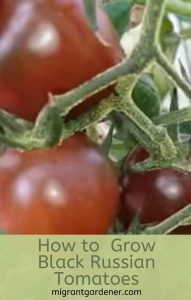Black Russian Tomato – How to Grow Black Russian Tomatoes
Black Russian Tomato – How to grow Black Russian Tomatoes – Black Russian tomato plants are said to have originated, as the name would suggest, in Russia.
However, other than that, there’s very little known about their heritage. It’s a good tomato plant for a cool greenhouse and outdoors. Keep in mind, it does spread quite a bit so do give it plenty of space.
Black Russian tomato plants are indeterminate in terms of growth habit. it grows with a thick leader and plenty of lengthy branches so the planting spacing needs to be in line with the spread. As such, it does need to be caged or staked.

Black Russian tomato plants are of the heirloom variety meaning it’s true to type. And in turn, that means you can retain seeds for the next tomato growing season.
In accordance with the name, the fruit is blackish, or at least a very dark brown in color when it ripens. Think along the lines of mahogany coloring.
Don’t let this dark color put you off – the fruit is rather lovely in many respects.
Fruit size varies between 2 and 4 inches in diameter. Likewise, the fruits vary from being almost completely rounded to having slight pleating over the skin’s exterior.
Fruit weight varies but it can easily reach 10.6 ounces/ 300 g – maybe more, sometimes less.
In terms of fruit production, it’s nothing short of excellent. The fruits develop in numerous small bunches.
If you notice that the flowers seem to be a bit misshapen, in my experience it’s best to remove those flowers. Otherwise, the fruit which leads on from these flowers is generally misshapen also.
Mind you, there’s nothing at all wrong with a misshaped tomato even if the supermarkets ‘say’ there is.
Is Black Russian tomato plant resistant to disease? This is something I’m not sure about. If anyone who has experience with Black Russian tomato plants wishes to comment that would be helpful.
How to Grow Black Russian Tomatoes
The plant, as with every tomato plant, does best in soil that is well-draining. Add some garden compost to your soil if growing outside.
Soil pH is ideal around the 6.5-7.0 mark – slightly acidic.
For added calcium, by all means, dig in some dolomite. Calcium is an essential element in healthy fruit production.
If you don’t have dolomite, many proprietary tomato feeds will come with appropriate levels of calcium.
Plant your Black Russian seedlings into the ground to the first set of leaves. This helps to promote additional root growth since the lower part of the stems will start to produce roots.
If you’re sowing directly from seed, add two or three seeds to each container. Later on, thin out the seedlings to a single plant.
For younger plants provide them with some seaweed solution once every few weeks. That is unless you’re using a tomato fertilizer.
For outdoor plants mulch the soil at the base of each plant. This helps to retain soil moisture.
Black Russian tomato plants are vigorous growers. They are also quite tolerant of cold weather conditions and can easily handle typical subtropical winter conditions.
As such, while they will grow perfectly well in a greenhouse, ensure that the ambient temperature is kept low. Black Russian tomato plants do not like high ambient temperatures.
For obvious reasons, fruit setting and growth are very slow throughout the cooler months of fall / autumn and winter – early springtime.
For me personally, I prefer not to prune this variety much at all unless I’m growing it in the greenhouse (in which case it certainly needs to be pruned).
It actually performs best when it’s left to sprawl so a cage or trellis is likely going to be better than staking the plant with single stakes.
Prune it hard if need be – to keep it confined. Definitely, though, you should trim out diseased and dead branches and take off yellowing leaves as soon as they appear.
Plant your Black Russian tomato seedlings so that the plant is able to reach maturity within a 60-90 day period in the springtime or in early summer.
Black Russian tomato plants are not too good at dealing with summertime heat. And on that note, this plant can easily become a victim of fungal diseases in the hot summer months.
Sow seeds in early March depending on where you are. Early March sowing is suitable for many parts of the U.S. and the U.K. Pot up the seedlings from early April on through late April.
If planting outdoors, harden off the seedlings during the second week of May onwards. Plant outside towards late May / early June.
Read: 7 Beneficial Insects for Tomato Plants
How to Use Black Russian Tomatoes
The taste of Black Russian fruit is semi-sweet with some acidity. Some people say it has a slightly smoky flavor. The aroma is mild.
The fruit does not store well. Best to consume when fresh.
The flavor and the aroma vary quite a bit. Likely that’s a correlation with the type of soil it’s grown in.
The fruit is best in fresh salads and on sandwiches. You can also add slices as a pizza topping.

We have several of these tomato plants. They grew and spread like crazy for us. Definitely going in our tomato patch ‘22! Perfect size for a southern biscuit and I’m not talking about a cookie.
Hi Teresa, thanks for your comment. Sounds like your tomatoes adore your soil and their environment as much as you adore the tomatoes. All the more for 2022!
Kind regards!
Joseph